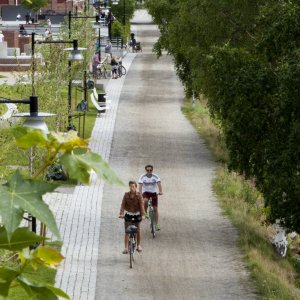
Editorial for March 2021 edition of NetworkNature Newsletter.
“Nature is good for us and the society”. That was – in short – the main message by the Millennium Ecosystem Assessment (MEA) back in 2005. The outcomes of the MEA were an eye-opener and have led to new knowledge and new concepts: Nature-based Solutions (NbS) is one of them.
With most Europeans living in cities, NbS situated in urban and peri-urban areas have a large potential to contribute to the well-being of urban dwellers. Simple interventions, as planting trees and giving them the chance to grow, have immediate impact on citizens’ health. A recent research published in Nature indicates that people who live less than 100 m of street trees need less antidepressant medication. More interesting is that the impact was more visible in individuals with low socio-economic status. This confirms outcomes from another study (2008) that populations who are exposed to green environments in their daily life, suffer from less health inequality. Deprived groups usually score lower on health and wellbeing indicators, and are more difficult to reach through health promotion campaigns. Both studies show that facilitating unintentional contact with nature – through living in a green environment – is an effective public health intervention, at no cost to the citizens, and at limited cost to the society. This is an interesting lesson for the post-COVID-19 recovery: building leafy cities can contribute the most to those at need. In this sense, it is unfortunate that we observe green gentrification in our cities: greener neighbourhoods become more expensive places to live, forcing vulnerable groups to leave. One of the suggested solutions to strive against green gentrification is to make the whole city greener, instead of focusing on specific districts. An alternate option is to target specific neighbourhoods, as done in the URBiNAT project, focusing the urban forestry strategy to provide sufficient trees in social housing neighbourhoods.
Urban trees can be perceived as old technology, but they have multiple benefits, and should be part of any NbS-based sustainable urbanisation pathway. Learn more on how to mobilise the multiple benefits of urban forests and urban trees during the forthcoming online Urban Forestry Days (23 - 24 March) organised by the European Forest Institute and the CLEARING HOUSE project, or during one of the multiple events of the NetworkNature Semester on NbS in the light of the Pandemic.
And do not forget to celebrate your favourite tree on the International Day of Forests on the 21st of March, keeping in mind - and being grateful for what they do for you!
- Prof Dr Rik De Vreese
European Forest Institute & Ghent University, CLEARING HOUSE project coordinator, European Forum on Urban Forestry Steering Committee member
Photo credit - Jimmie Schmoranz, Umea Kommun

